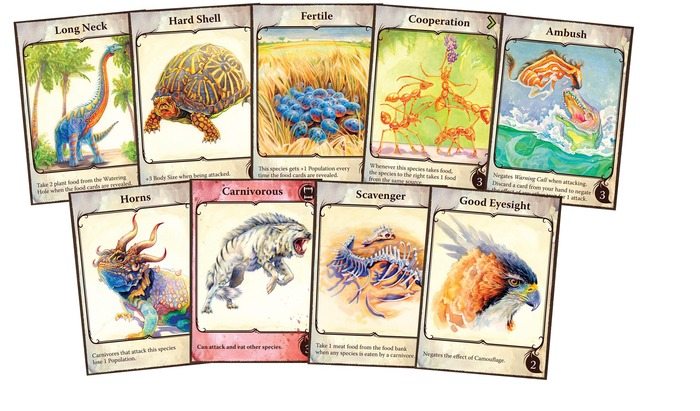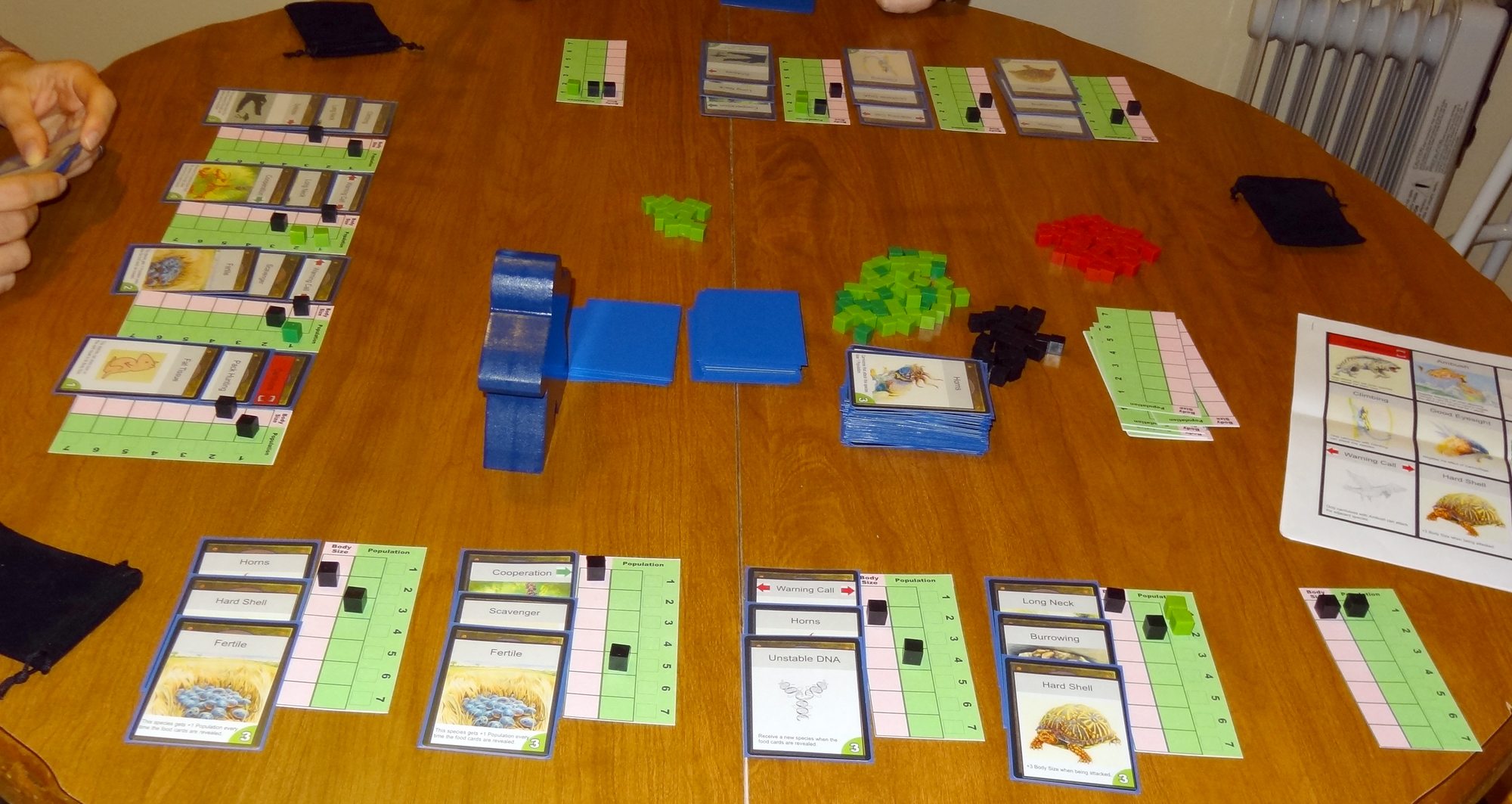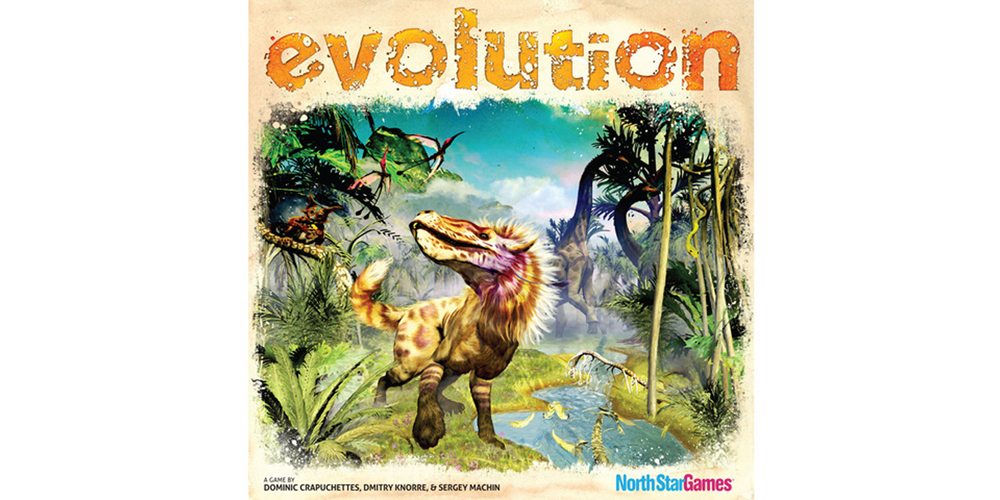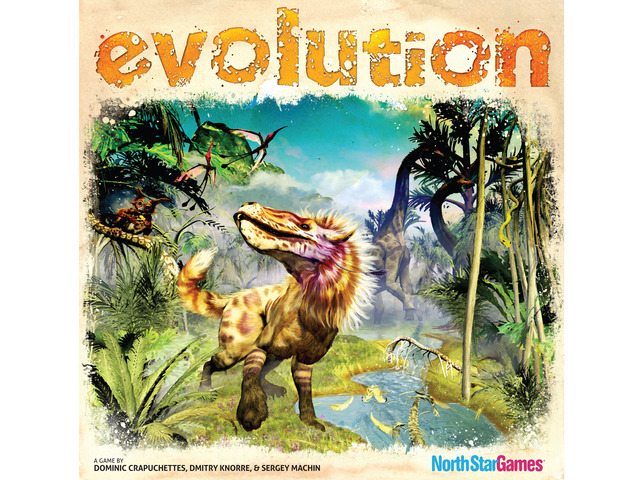What’s the best way for a species to survive? A long neck helps you get out-of-reach food, but camouflage protects you from predators … until they evolve some keen eyesight. Or maybe you go for safety in numbers, so that even if a few get eaten the species will live on. Evolution, by North Star Games, puts you in charge of adapting your species to the changing ecosystem.
At a glance: Evolution is for 2 to 5 players, ages 11 and up, and takes about an hour to play. The game is currently on Kickstarter, and the basic pledge level for a copy of the game is $50. I highly recommend using the “Quick Play” option, which speeds up the game and reduces down-time for the players. The age recommendation seems about right, though experienced younger players may be able to handle the game as well—while it’s not really an educational game, I think it does make a pretty good illustration of adaptation.

The game comes with:
- 1 Watering Hole Board
- 1 Start Player Marker
- 117 Traits Cards
- 22 Species Boards
- 44 Wooden Markers
- 175 Food Tokens
- 5 Food Token Bags
- 5 Player Aids
I got to try a prototype version, which had incomplete card design and artwork and didn’t have the Watering Hole Board, but I got a good feel for the gameplay and how it works.
The artwork, by Catherine Hamilton, is pretty nice: they almost look like illustrations you’d find in a biology book about animals with different traits and how they work. Not all of the artwork is completely real—the “Horns” card shows what looks like a horned lizard with really enormous horns—but they’re done in a style that’s realistic.

How to Play:
The goal of the game is to have the most points, which you get for traits and population of species that are alive at the end of the game, plus all the food your species consume throughout the game.
To set up: All of the traits cards are shuffled into one deck. A starting player is chosen at random and given the start player marker. Everyone gets a food token bag and one species board, and places markers on the board to indicate population 1 and body size 1. The food tokens, extra species boards, and markers are all placed in the center.
Each round, you get cards, set the food supply, use your cards to evolve species, and then collect food.
Get cards: Each player gets 3 cards, plus 1 for each species they currently have.
Food supply: Each trait card has a number in the bottom corner. You’ll pick one card from your hand and place it face down in the center—later this will add to the food supply for the round.
Use cards: You may use trait cards in several ways. First, you may play them (face-down) next to a species to give it that trait. Each species may have up to three traits—if you play more, then you’ll have to discard existing traits to make room. You may also discard cards to increase your population, increase your body size, or gain a new species. Using Quick Play rules means that everyone does this phase simultaneously, rather than waiting for each person in turn to use cards. Unused cards are kept in your hand for the next round.
Once everyone has finished playing cards, the traits on your species are turned face-up and revealed, and the cards placed in the food supply are also revealed. Add a number of food tokens from the food bank to form the food supply—these represent the amount of plant food available this round.
Collect food: In turn order, each player feeds one species, continuing until all species have been fed (or there’s no more food). To feed a species, you take one plant food from the food supply and add it to a species board, up to one food per population. If your species is a Carnivore, however, you’ll need to attack another species and eat it for food.
To attack, you first compare body size—you must have a larger body size than your prey. Then, you check to see if the prey has any traits that protect it, and whether you have traits to counteract those defenses. For instance, you can’t eat a Climbing animal unless you have Climbing as well. Good Eyesight overcomes Camouflage. Pack Hunting adds 3 to your body size when hunting, while Hard Shell adds 3 when you’re attacked. Ambush overcomes the Warning Call, and also allows you to discard cards from your hand to ignore one trait card while you’re attacking.
If you successfully attack a species, then that species decreases population by 1, and you gain meat food equal to the body size of that species. The bigger the animal, the more food you get. (Of course, you’re still limited by your Carnivore’s population, too—any extra food just gets discarded.)
Once everyone has eaten to their fill or there is no more food left in the supply (or no more prey that can be eaten), you check to see if anyone starves. Decrease your population of each species down to the level of food it has collected. Finally, you take all the food you’ve eaten this round and put it into your food token bag.
The start player marker passes to the left, and another round begins.

When the deck runs out of cards, you’ll reshuffle it once, and play one final round.
At the end of the game, you’ll get one point for each food in your bag, one point for each surviving population, and one point for each trait on a species. You don’t get any points for trait cards left in your hand.
Verdict
Evolution was first published in 2010 by Rightgames, though there are a few significant differences between the original rules and this version. North Star Games, which is better known for party games like Wits & Wagers, wants to get into strategy games, and this is their first entry. They revamped the rules and got new artwork, and I think they’ve got a hit. (And judging by their current funding on Kickstarter, a lot of backers agree!)
I’ve gotten to play a few games of Evolution, and one of the things I really like about it is the way that the feel of the game can change significantly based on the ecosystem: how much plant food is available? How many carnivores are there (and how big are they)? Has everyone been evolving similar traits or is there a lot of diversity?
I’ve played games in which we actually ran out of meat food cubes (the prototype uses red cubes and green cubes, rather than the double-sided tokens planned for the final version) because we had several very hungry carnivores, along with a few scavengers that got meat anytime a carnivore had a meal. Another time, we always had so much plant food that none of the plant eaters ever went hungry. You can play where it’s mostly a peaceful kingdom full of plant eaters, but eventually somebody will probably decide that there’s just too much delicious meat grazing the fields.
Once somebody introduces a carnivore into the ecosystem, it can turn into an evolutionary arms race. Your species can climb? My carnivore learned to climb, too. Oh, now all the climbers are gone but some other species have developed camouflage. Time to get some good eyesight so I can spot them anyway. You have a hard shell? I just got three sizes bigger to compensate.

It’s also cool to find combinations of traits that work well together. For instance, Long Neck lets you grab two food from the bank right as cards are revealed, and Burrowing keeps you safe from predators if all of your population has been fed. Put them together with a population of 2, and you have a creature that pokes its head up, grabs enough food, and then hides again.
I like the way that the cards can be used for different things, which presents you with some nice choices throughout the game: increasing your population can help your species survive even if you get attacked—but the right traits can protect you from being attacked. Growing your size can help defend you against predators, but it also makes you a more attractive target, because bigger animals provide more food. Creating a lot of tiny species with few traits can get you more cards in your hand … if they survive the round. And another tough decision is which card to use for the food supply: you can put in a low number and hope that somebody else starves, but you have to make sure there’s enough for you to feed all of your own species, too.
There is some luck involved: sometimes one player might have a big predator and you just can’t get any defense cards. Or, maybe you’re the carnivore and everyone else’s animals have great defenses and you just can’t find the traits that counteract them. In those cases, the game can feel frustrating because you know what you should do but you just don’t have the cards.
For the most part, though, I think there are enough copies of each card and enough different ways to use the cards you have that you can find something to do on each turn that benefits you. The trick is finding the best way to adapt to the state of the world using the resources at your disposal.
I do recommend using the Quick Play rules as long as you can trust everyone at the table to (1) be honest and (2) understand the rules. It means that everyone can play cards and evolve their species simultaneously, rather than waiting for each player to take their turns individually. One advantage to the Quick Play is that a 5-player game is actually fastest, because you’ll run out of cards more quickly with more players, but the rounds take the same amount of time.
The game can get cutthroat at times, so if you’re playing with kids or sensitive adults, be forewarned—you may hurt somebody’s feelings when you eat their species into extinction. But, hey, tell them it’s not personal: it’s survival of the fittest. (Let me know how well that goes over.)
Overall, I’ve enjoyed playing Evolution and I look forward to playing some more. I’m excited to see the final look of the game with the new artwork, and I think it’s a pretty solid title for North Star Games. Although this is North Star Games’ first Kickstarter campaign, it’s definitely not their first time publishing and distributing a board game, so I’m not too concerned about their ability to produce a game, nor am I worried at all about the money disappearing into a hole somewhere. They do admit in their “Risks and challenges” section that the timeline is pretty tight, so it’s possible there could be delays, but that’s a fairly small concern. For more information and to pledge for a copy, visit the Kickstarter page.
Disclosure: GeekDad received a demo prototype of this game.





